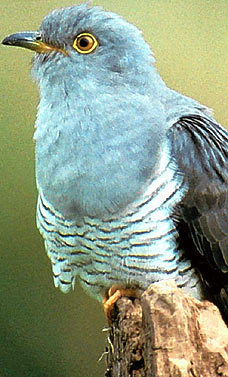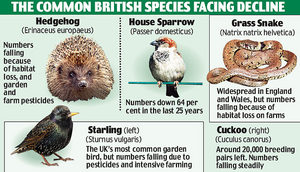But decades of intensive farming, chemical pollution and habitat loss have taken their toll on some of our bestloved wildlife.
From today, the cuckoo, hedgehog and house sparrow join the official 'priority' list of the UK's most threatened animals.

|
| ©Unknown |
| Cuckoos are among birds threatened |
According to the Government, more than 1,000 plants and animals are under threat from extinction or serious decline - twice the number on the last major conservation list published a decade ago.

|
| ©Daily Mail |
The plight of many of the animals - such as the red squirrel, bittern or grass snake - is well known. But many will be surprised to see creatures such as the starling, herring gull and hedgehog featured.
The UK Biodiversity Action Plan involved more than 500 wildlife experts and took
more than two years to compile. The list names 1,149 species of mammals, birds, insects, invertebrates, plants, fish, fungi and sea creatures - along with 65 habitats.
Every species named is protected by law.
The threat to wildlife is so great that one fifth of all the bird species seen in Britain are considered as 'at risk'.
The list features 59 birds which have seen their numbers halve in the last 25 years, including the lesser spotted woodpecker, the yellow wagtail, the yellowhammer, the house sparrow and the lapwing. While there might appear to be no shortage of starlings, their numbers have plummeted to a worrying degree.
Dr Mark Avery, of the Royal Society for the Protection of Birds, said the Biodiversity Action Plan system had helped increase numbers of key species such as the bittern, cirl bunting and woodlark.
However, he said it was a "cause for alarm" that the bird list now included more than a fifth of all the UK's regularly occurring birds.
The plan will be used to decide which species and habitats should be targeted for conservation work.
Invertebrates dominate the atrisk list, with more than 400 bugs, beetles and spiders named. The garden tiger moth and the grass snake join previously prioritised creatures such as the otter and bottlenosed dolphin.
In the seas, long- snouted and short-snouted seahorse species are classified as under threat.
Marsh orchids and two threatened species of dandelion are among the plants which have been included.
Biodiversity minister Joan Ruddock said the Government was aiming to halt biodiversity loss by 2010. She added: "Our climate is changing and it is therefore more important than ever that our conservation efforts help our important-wildlife habitats to adapt and increase their chances of survival."
According to conservationists, the greatest threat comes from intensive farming - and the destruction of hedgerows or meadows, and the heavy-handed use of pesticides.
Changes in the way rivers and canals are maintained have also hit species, as has housing and industrial development.
One of the endangered spiders - the distinguished jumper - lives on only two sites near the Thames in Essex. One is under threat from the Royal Mail's plans to build a major distribution centre.



Reader Comments
to our Newsletter